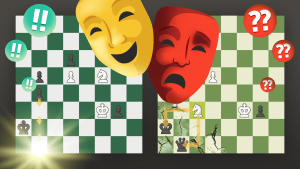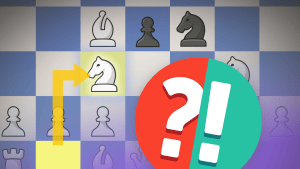
Three Fools
About 30 years ago I was playing in a kid's team tournament. I don't remember who won the tournament, my own result or even who played there. The only thing I remember about the tournament is what happened during one of our team's gatherings. It was a rule that after each round we analyzed the games we just played and our coach would show us our mistakes. Now imagine, one of our team mates shows his game which he lost and our coach asks him why he played his last move. The kid starts explaining that he tried to achieve the notorious "two Bishops advantage". The position was completely closed and of course his two Bishops were absolutely meaningless but he heard somewhere about the strength of two Bishops and this random knowledge affected his decision-making process. I will always remember what our coach told him. It is not easy to translate his pun, but roughly translated it sounded like this: " Look at the position! Where do you see two Bishops? There are no two Bishops! I see only two fools! No, actually, I see three fools, because you are the third one!" And of course our whole team (including ''the third fool" guy) was rolling on the floor laughing.
It was a completely different innocent time, so please don't criticize our coach for calling one of his students a fool. These days it is an absolutely unimaginable thing to do and in our litigious society you could even get sued for it. But again, I am talking about something that took place 30 years ago. We really loved our coach and one of the benefits of his approach is that even 30 years later I still remember his lessons!
Getting back to the Two Bishops, it is one of the biggest misconceptions I see in my students' games. Yes, in some positions Two Bishops are really great. But first of all, it is a certain type of the position where you can really talk about the ''advantage of Two Bishops" and also, even in this case, it requires some skills to use this advantage. And yet, some of my students, who cannot even convert an extra Knight into a win, talk about the ''advantage of Two Bishops" (which is especially funny to hear when it simply doesn't exist, just like in the game of my teammate 30 years ago).
So, let's talk about the difference between a Bishop and a Knight and this knowledge should help us to understand better the situations where Two Bishops really shine.
The main difference between these two guys is that a Bishop is a far ranged piece but a Knight needs to be very close to the opponent's pieces to really hit them. But in order to stay close to the opponent's pieces, a Knight needs some squares where it can be supported (preferably by pawns). This simple logic explains why in the closed positions (with pawns in the center) the Bishops are not very active (restricted by pawns) and the Knights (supported by pawns) sometimes are even better than Bishops! Meanwhile in an open position the Bishops are far superior, especially if there are targets on both sides of the board. For example, Be3 can simultaneously hit Black pawns on the different wings (say the a7 and h6 pawns). A Knight cannot do this simple trick.
Therefore, the correct technique of using the Two Bishops advantage is by placing your pawns the way that they restrict your opponent Knights and leave them no good squares where they can be supported by a pawn. Then slowly squeeze your opponent pieces and finally break his position which strangely enough frequently involves a trade of your Bishops!
Let's look at the games of the founder of the Modern positional school of chess, the first World Champion Wilhelm Steinitz. He makes it look simple!
Ten years later, Steinitz played a similar masterpiece:
to be continued...

